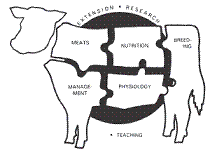Animal Science, Department of

Nebraska Beef Cattle Reports
Date of this Version
2022
Citation
2022 Nebraska Beef Cattle Report
UNL Beef, Institute of Agriculture and Natural Resources, University of Nebraska-Lincoln
Abstract
Meat color is a major factor for consumer meat purchasing decisions. Aging beef, which can improve tenderness, has been shown to accelerate discoloration in fresh beef, shortening retail display time, and generating negative flavor attributes. The objective of this study was to evaluate supplementing cattle high levels (2,200 International Units/ day) of Vitamin E to sustain meat quality during prolonged retail display in beef strip loins after 2 or 14 days aging compared to commercially-produced loins selected as controls. Results showed a treatment x age effect for Warner-Bratzler shear force and free calcium content, primarily due to aging. A dietary treatment x age x day interaction in redness (a*) and subjective discoloration occurred. High vitamin E samples exhibited more acceptable color scores compared to Control samples throughout retail display. As aging increased (14 days vs 2 days), Vitamin E samples sustained color better than Control samples, as shown by delta E (overall color change) values. A dietary treatment x day effect in lipid oxidation occurred with Vitamin E samples having significantly less malonaldehyde than Control samples. No differences in slice shear force, moisture, fat, or ash content were found. Supplementing high levels of Vitamin E to cattle resulted in sustained meat color and oxidative stability compared to commercially-produced cattle
Included in
Large or Food Animal and Equine Medicine Commons, Meat Science Commons, Veterinary Preventive Medicine, Epidemiology, and Public Health Commons

